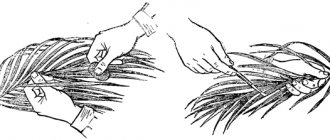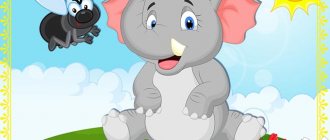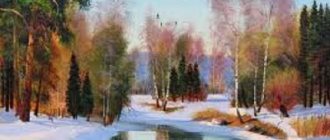Let's play. Mobile Russian folk game "Woodpecker"
Children stand in a circle. The child playing the role of a woodpecker stands in the middle of the circle. Children dance around the woodpecker and say the first two lines:
“A woodpecker walks by the granary,
Looking for a grain of wheat."
The woodpecker says in response:
“I’m not bored alone, I’ll take whoever I want.”
With the last word, the woodpecker quickly takes the hand of one of the guys in the circle. And the children must quickly stand in pairs. The child left without a mate becomes a woodpecker in the next game.
Purpose of the lesson: to expand children’s knowledge about the wintering birds of our region. Objectives of the lesson: - activate adjectives in speech; — teach children to answer questions not in short phrases, but in complete sentences; — teach children to compose a descriptive story using a question plan; - nurturing love and care for birds. Equipment: sound recording “Seasons”; artificial trees, fabric bags, illustrations of birds, food; decorated screen with a forest image. Progress of the lesson: - Guys, today we will go for a walk in the winter forest. (The music “Voices of Birds” sounds). Listen carefully to the sounds and tell me what you heard in the winter forest? (Bird voices). — Guys, you named me a lot of birds. But you know that some birds fly to warmer regions in the fall, while others remain to spend the winter with us. — What are the names of the birds that stay with us for the winter? — What wintering birds do you know? And now we will take a walk through the winter forest and see who lives in it. - Guys, there’s someone sitting on the Christmas tree and looking around. - Who is this? -What is the name of this bird? Let's, guys, listen to a poem about a sparrow. Sparrows - little sparrows, Little gray feathers... Peck, peck the crumbs from my palm! No, they don’t peck you from your palm and don’t let you pet them. How can we get along, so that we can stroke. - Now, look carefully at the sparrow and say: *What size is it? *What color are his feathers? *How many legs does a sparrow have? *Why do sparrows need paws? *How does a sparrow move? *What do sparrows eat? Physical education - Guys, now listen to the riddle and try to guess it. A fidgety little bird, almost all yellow, loves lard and wheat. Who recognized her? And now (Masha N.) will tell us a poem about a titmouse. A small bird - a yellow-breasted titmouse, walks around the yard, collects crumbs. — What else does a titmouse eat? Guys. Do you know that in November some people celebrate “titmouse day” - they install feeders on trees, scatter seeds and grains, and hang pieces of salted lard outside the window. People say: “The titmouse is not a big bird, but even then it knows its holiday.” - And now, guys, we’ll play. The game is called “Who Screams?” (I show birds: a sparrow, a titmouse. How does a sparrow scream? How does a titmouse sound? First in chorus, and then ask one). - Now let’s complicate the game. If I raise the picture up, then you say it loudly, but if you sit down, then you say it quietly. - Guys, listen to another poem that Nastya K. told us. On branches decorated with snow fringe, ruddy apples grew in winter. The apples on the apple tree are scurrying merrily, the ice cream caterpillars are pecking at the apples. - What kind of apples are these, guys? - Why were they called apples? Well done! You know well the birds that winter in our area. Do you know that in winter the birds are hungry and cannot always find food for themselves. That's why they fly closer to people. And we will feed them. “We’ll find out what we’re going to feed the birds now during the game.” Game “Identify food by touch.” (I have food in bags. Your task: feel with your hands, identify and name the food). With the onset of cold weather, wintering birds fly to human habitation. The most difficult time has come for the birds: they cannot always find food. The wheat and rye crops were removed from the fields, and the insects disappeared. Therefore, birds fly closer to people, hoping that they will feed them. — Guys, will we feed the birds in late autumn and winter so that they do not die from hunger and cold? Today you and I will go for a walk, take homemade feeders with us, hang them on the trees and watch how the birds peck at the food. Next, the teacher and the children go with feeders to feed the birds.
Tales about birds. Woodpecker.
Why is the woodpecker respected by all birds and animals? And what would happen if woodpeckers disappeared? This is talked about in the fairy tale “The Woodpecker.”
Woodpecker worker. Tales of Lake Baikal
Birds from all over the taiga flew in and began to scold the woodpecker.
The cuckoo is the angriest of all: “You give me no peace, woodpecker, you knock, you knock!”
“Your knocking makes my head hurt,” the nutcracker complains.
- Idlers, you have ready-made food: flies, mosquitoes, boogers, berries, tree buds, nuts. And I need to chisel the tree, look for beetles under the bark. I save you all, ungrateful ones, I work from morning to night!
The birds whistled, chirped, and chattered angrily: “What!” Are you saving us? - Look, what a braggart! - Let's peck him!
The din of birds was interrupted by a capercaillie - an important bird in the taiga, it does not throw words to the wind. He stamped his foot: “You shouldn’t make a fuss, the woodpecker told the truth!” It protects trees from greedy bark beetles. Without it, they would have devoured all the trees and devastated the taiga. How can we live without the taiga?.. Screamers!
The cuckoo, sitting on a tall pine tree, was the first to sing throughout the whole taiga: “Pucko-coo, woodpecker, peek-a-boo, darling!”
Behind her is a nutcracker: “I praise you, buddy.” Come on - knock, knock.
- Knock-knock - good sound! - the forest pigeon shouted loudly.
The birds surrounded the woodpecker, the violator of the forest silence, and sang in chorus.
Summary of GCD in kindergarten in the middle group. Birds of the forest
Abstract of the educational activity a child discovers the world of nature in the middle group on the topic “Birds of the Forest”
Author: Victoria Evgenievna Novoselka, teacher, MKDOU “Karablik Kindergarten” Description: the work will be useful for kindergarten teachers, middle group. The lesson can be carried out as part of the thematic week “Birds” and during a lesson in the educational area: the child discovers the natural world. Age: 4-5 years, middle group Purpose: development of mental operations: analysis and synthesis. Tasks: - repeat the name of the birds, remember their appearance; - learn to identify the body parts of birds, their distinctive features; — update knowledge about bird nutrition in memory; - promote the development of thought processes: analysis and synthesis in naming objects in a general word, in identifying parts of a bird’s body; Materials: pictures of birds, figurines of birds, pictures of food, ball, bell.
Move
1. Organizational moment
Educator: Let's greet you with a bell and affectionately call your name.
- Hello, Mirochka, ding-ding (bell ringing) - Hello, Victoria Evgenievna, ding-ding. 2. Main part
Educator: - There are pictures in front of you, what are they? (Children name pictures, birds). - I will ask a riddle, and you will guess, find a picture and name it. Who's on the tree, on the bough, is keeping score: “kuckoo, peek-a-boo?”
(Cuckoo)
Here the feathered one sat on a branch and pounded: knock-knock-knock!
He looks for food under the bark when he is hungry. (Woodpecker)
Look at the balcony: He has been cooing here since the morning.
This bird is a postman, It will fly any route. (Pigeon)
The largest, the strongest, circling in the sky during the long night.
From a large family of owls, the Hook-nosed predator... (Eagle owl)
Black, darker than the darkness, There are no birds, he is smarter.
On a tall spruce tree - there he is. This is an old, wise... (Raven)
There is a palace on the pole, In the palace there is a singer.
(Starling)
Educator: - Which birds did you guess? (starling, raven, eagle owl, pigeon, woodpecker, cuckoo). - What are they called all together? (Birds) - Well done! Where do these birds live? (In the forest). Game: “Find a common word” - I will show you pictures, they will show something, and you will have to say what they are called in one word. Elk, fox, bear, lynx, wolf. (animals). Fly, butterfly, grasshopper, ant, mosquito. (Insects). Birch, spruce, pine, oak. (Trees) Chamomile, cornflower, clover, dandelion. (Flowers). Let's take a look and remember who is drawn in the pictures? (Together with the teacher, name who is drawn in the pictures, and then name with a generalizing word). - Children, I suggest you play pigeon a little. You know what a pigeon does with its head when it walks, it tilts it. To improve brain activity, perform the Head Shaking exercise with your child.
This exercise stimulates thought processes. Let's sit as comfortably as we can.
Let's breathe deeply (the teacher shows how), let's drop our heads forward. We will slowly shake our head from side to side (with the help of breathing, the tension goes away. The chin draws a slightly curved line of the chest as the neck relaxes. Perform for 30 seconds. Teacher: - This is how a dove shakes its head at us. The teacher shows a toy pigeon and depicts how it shakes its head. - Children, did you like playing with a pigeon? Let’s turn back into children. Game: “Dividing a whole into parts” Educator: - There are different birds in front of you, do you recognize them? Name them. (children name the birds, if they can’t name them, the teacher helps) . - Choose any bird that you like, we will play with it. (children choose 1 bird, take it in their hands, the rest of the birds are put aside). - Now let’s select the bird’s body parts. Which ones do you see? (head, body , wings, legs, beak and eyes on the head) The teacher asks the child to pronounce out loud the parts of the bird’s body and show them. Remember that birds have plumage. If the child easily copes with the task, you can turn on the complication. Let the child divide the bird into parts and lays out the sticks on the table: as many parts as there are, the same number of sticks. - Well done, how well you did! — Birds probably like to eat something. Let's help the birds find the food they eat. Game: “What do birds eat” - There are pictures in front of you, you need to choose and put the food that it eats next to the bird. Be careful, because birds don’t eat everything. (From a group of pictures, the child selects only those that depict birds eating) - Children, name what kind of food you chose for the bird. If the child makes a mistake, the teacher helps him remember what birds eat. - Tell me, what can birds do that people can’t? (Fly) Game: “Flies - does not fly.” Educator: - Now let's play a fun game in which I will name words and throw you a ball.
You will quickly return the ball to me, and say whether the object flies or does not fly. • cloud • apple • rook • crow • pasta • helicopter • plane • butterfly • teapot • dove • goat • starling - Children, what birds did you meet in the game? (rook, crow, dove, starling) 3. Conclusion
- Children, what birds do you remember today? —Which bird did you like best? — What do birds eat? — What body parts does a bird have? Very good! Our lesson is over, you tried very hard, you studied - well done!
We recommend watching:
GCD summary in the middle group “Visiting the Traffic Light” GCD summary in the middle group on the theme “New Year” Quiz “Bird Experts” for preschool children of the preparatory group GCD summary in the senior group of kindergarten with a presentation. Topic: “Feathered Friends”
Similar articles:
Quiz on the theme “Birds” for children 6-7 years old
Riddles about birds for children 5-7 years old with answers
Poems about birds for children 2-3 years old in kindergarten
Summary of continuous direct educational activities in the middle group
Summary of GCD in the senior group on the topic “So that your teeth don’t hurt”





